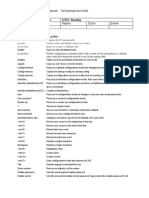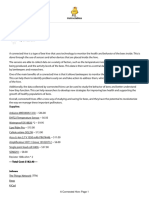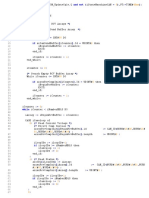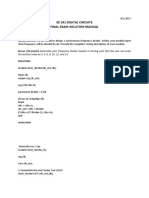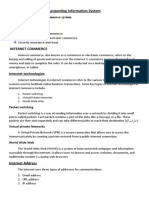Non Blocking I2C Read Function (Arduino)
Uploaded by
Bruno VoltzNon Blocking I2C Read Function (Arduino)
Uploaded by
Bruno VoltzNon blocking I2C read function – Programming for Engineers http://programming4engineers.org/?
p=122
1. #ifndef FASTWIRE_H
2. #define FASTWIRE_H
3. #include <inttypes.h> // uint8_t is defined here
4.
5. void FastWireSend(uint8_t reg, uint8_t dat);
6. void FastWireRead(uint8_t reg, uint8_t * buf, uint8_t n);
7. uint8_t FastWireIsBusy(void);
8.
9. #endif
1. #include "FastWire.h"
2. #include <avr/io.h> // The I2C registers are defined here
3. #include <avr/interrupt.h>
4.
5. // Status messeges from I2C
1 sur 4 12/07/2018 à 17:30
Non blocking I2C read function – Programming for Engineers http://programming4engineers.org/?p=122
6. #define MT_START 0x08
7. #define MT_SLA_ACK 0x18
8. #define MT_DATA_ACK 0x28
9. #define MR_START 0x10 // repeated start
10. #define MR_SLA_ACK 0x40
11. #define MR_SLA_NACK 0x48
12. #define MR_DATA_ACK 0x50
13. #define MR_DATA_NACK 0x58
14.
15. // These are specific to MPU6050 and should be changed if used with other components
16. #define SLA_W 0xD0 // 11010000 // (208)
17. #define SLA_R 0xD1 // 11010001 // (209)
18.
19. static uint8_t I2Cwritebuffer[2];
20. static volatile uint8_t I2Cwrite_n = 0;
21. static volatile uint8_t I2Cwrite_i = 0;
22. static volatile uint8_t I2Cwrite_sendstop = 0;
23. static uint8_t * I2Creadbuffer;
24. static volatile uint8_t I2Cread_i = 0;
25. static volatile uint8_t I2Cbusy = 0;
26.
27. void FastWireSend(uint8_t reg, uint8_t dat){
28. // Wait for free line
29. while(I2Cbusy != 0);
30. while(TWCR & (1 << TWSTO));
31. I2Cwritebuffer[0] = reg;
32. I2Cwritebuffer[1] = dat;
33. I2Cwrite_n = 2;
34. I2Cwrite_i = 0;
35. I2Cwrite_sendstop = 1;
36.
37. I2Cbusy = 1;
38.
39. // Initiate the I2C comunication
40. TWCR =(1<<TWINT) | (1<<TWSTA) | (1<<TWEN) | (1<<TWIE);
41. }
42.
43. void FastWireRead(uint8_t reg, uint8_t * buf, uint8_t n){
44. // Wait for free line
45. while(I2Cbusy != 0);
46. while(TWCR & (1 << TWSTO));
47. I2Cwritebuffer[0] = reg;
48. I2Cwrite_n = 1;
49. I2Cwrite_i = 0;
50. I2Cwrite_sendstop = 0;
51. I2Creadbuffer = buf;
52. I2Cread_i = n-1;
53.
54. I2Cbusy = 1;
55.
56. // Initiate the I2C comunication
57. TWCR =(1<<TWINT) | (1<<TWSTA) | (1<<TWEN) | (1<<TWIE);
58. }
59.
60. uint8_t FastWireIsBusy(void){
61. return I2Cbusy;
62. }
63. /******************************************************************
64. The interrupt that does all the work
65. */
66. ISR(TWI_vect)
67. {
68. switch(TWSR & 0xF8){
69. case MT_START:
70. // Send the slave address and write bit
71. TWDR = SLA_W;
72. I2Cbusy = 2;
2 sur 4 12/07/2018 à 17:30
Non blocking I2C read function – Programming for Engineers http://programming4engineers.org/?p=122
73. TWCR = (1<<TWINT) | (1<<TWEN) | (1<<TWIE);
74. break;
75. case MT_SLA_ACK:
76. I2Cbusy = 3;
77. // Send the data in the transmit buffer
78. TWDR = I2Cwritebuffer[I2Cwrite_i];
79. I2Cwrite_i ++;
80. TWCR = (1<<TWINT) | (1<<TWEN) | (1<<TWIE);
81. break;
82. case MT_DATA_ACK:
83. I2Cbusy = 4;
84. // Send more data or send stop signal
85. if (I2Cwrite_i < I2Cwrite_n){
86. TWDR = I2Cwritebuffer[I2Cwrite_i];
87. I2Cwrite_i ++;
88. TWCR = (1<<TWINT) | (1<<TWEN) | (1<<TWIE);
89. }else{
90. if (I2Cwrite_sendstop){
91. // Stop the transmission
92. TWCR = (1<<TWINT) | (1<<TWEN) | (1<<TWSTO) | (1<<TWIE);
93. I2Cbusy = 0;
94. }else{
95. // Start recieving data by sending a start signal
96. TWCR =(1<<TWINT) | (1<<TWSTA) | (1<<TWEN) | (1<<TWIE);
97. I2Cbusy = 1;
98. }
99. }
100. break;
101. case MR_START:
102. TWDR = SLA_R;
103. I2Cbusy = 5;
104. TWCR = (1<<TWINT) | (1<<TWEN) | (1<<TWIE);
105. break;
106. case MR_SLA_ACK:
107. I2Cbusy = 6;
108. // Ask for the first uint8_t of data
109. if (I2Cread_i == 0){
110. // send NACK
111. TWCR = (1<<TWINT) | (1<<TWEN) | (1<<TWIE);
112. }else{
113. TWCR = (1<<TWINT) | (1<<TWEA) | (1<<TWEN) | (1<<TWIE);
114. }
115. break;
116. // case MR_SLA_NACK:
117. // I2Cbusy = 8;
118. // break;
119. case MR_DATA_ACK:
120. I2Cbusy = 7;
121. // Save data in buffer
122. I2Creadbuffer[I2Cread_i] = TWDR;
123. // In case there is more data to read, ask for more
124. if (I2Cread_i == 1){
125. // send NACK
126. TWCR = (1<<TWINT) | (1<<TWEN) | (1<<TWIE);
127. }else{
128. TWCR = (1<<TWINT) | (1<<TWEA) | (1<<TWEN) | (1<<TWIE);
129. }
130. I2Cread_i--;
131. break;
132. case MR_DATA_NACK:
133. // Save the lase uint8_t
134. I2Creadbuffer[I2Cread_i] = TWDR;
135. // End the transmission
136. TWCR = (1<<TWINT) | (1<<TWSTO) | (1<<TWEN) | (1<<TWIE);
137. I2Cbusy = 0;
138. break;
139. default:
3 sur 4 12/07/2018 à 17:30
Non blocking I2C read function – Programming for Engineers http://programming4engineers.org/?p=122
140. I2Cbusy = TWSR;
141. }
142. }
4 sur 4 12/07/2018 à 17:30
You might also like
- Hex Editor Tutorial Managing National Teams - Football Manager100% (1)Hex Editor Tutorial Managing National Teams - Football Manager13 pages
- F - Cpu: #Define #Include #Include #IncludeNo ratings yetF - Cpu: #Define #Include #Include #Include8 pages
- Add A DS1307 RTC Clock To Your AVR MicrocontrollerNo ratings yetAdd A DS1307 RTC Clock To Your AVR Microcontroller14 pages
- How To Interface I2C-EEPROM With LPC2148 - ARM7 SlickerNo ratings yetHow To Interface I2C-EEPROM With LPC2148 - ARM7 Slicker8 pages
- Arduino and DS3231 Real Time Clock: Hardware RequiredNo ratings yetArduino and DS3231 Real Time Clock: Hardware Required6 pages
- Embedded System Laboratory Instruction Sheet Experiment No. 06 Experiment NameNo ratings yetEmbedded System Laboratory Instruction Sheet Experiment No. 06 Experiment Name5 pages
- Embedded IOT Project - Garbage Segregation & Level IndicationNo ratings yetEmbedded IOT Project - Garbage Segregation & Level Indication8 pages
- Ihsan Prasetya_Scan EKTP+Alat Tinggi BadanNo ratings yetIhsan Prasetya_Scan EKTP+Alat Tinggi Badan4 pages
- Ee 241 Digital Circuits Final Exam Solution ManualNo ratings yetEe 241 Digital Circuits Final Exam Solution Manual10 pages
- Combined Turbidity & Temp Sensors With Esp 8266No ratings yetCombined Turbidity & Temp Sensors With Esp 82664 pages
- Manual Adjust For RTC Clock With Arduino and 7-Segment LED100% (1)Manual Adjust For RTC Clock With Arduino and 7-Segment LED21 pages
- Real-Time Operating Systems Examples With Freertos: Microprocessor-Based Systems (E155) Prof. Josh BrakeNo ratings yetReal-Time Operating Systems Examples With Freertos: Microprocessor-Based Systems (E155) Prof. Josh Brake19 pages
- Transforming Your AVR Microcontroller To The I2C or TWI Slave I - O Expander Project - ErmicroblogNo ratings yetTransforming Your AVR Microcontroller To The I2C or TWI Slave I - O Expander Project - Ermicroblog18 pages
- W5500 UDP Problem - Open Hardware - W5500 Ethernet Shield - WIZnet Developer ForumNo ratings yetW5500 UDP Problem - Open Hardware - W5500 Ethernet Shield - WIZnet Developer Forum8 pages
- ESP8266 DHT11 Humidity Temperature Data LoggerNo ratings yetESP8266 DHT11 Humidity Temperature Data Logger6 pages
- Advanced Computer Networks - Laboratory - 2 by - Vishal Jain (19103125)No ratings yetAdvanced Computer Networks - Laboratory - 2 by - Vishal Jain (19103125)4 pages
- Course: Microcontrollers and Interfacing Module: II - MSP 430 Microcontroller Topic: MSP430 Timer InterruptNo ratings yetCourse: Microcontrollers and Interfacing Module: II - MSP 430 Microcontroller Topic: MSP430 Timer Interrupt13 pages
- 5KG Small Scale Load Cell Weighing Pressure Sensor With A-D HX711AD Adapter (Banggood)No ratings yet5KG Small Scale Load Cell Weighing Pressure Sensor With A-D HX711AD Adapter (Banggood)5 pages
- A Detailed Study of An Internet of Things IotNo ratings yetA Detailed Study of An Internet of Things Iot7 pages
- Implementing Cisco SD-WAN Solutions (SDWAN300) v1.0: What You'll Learn in This CourseNo ratings yetImplementing Cisco SD-WAN Solutions (SDWAN300) v1.0: What You'll Learn in This Course4 pages
- Dell G3 15 3500 - Selek G3 MLK N18P - 19795-1No ratings yetDell G3 15 3500 - Selek G3 MLK N18P - 19795-1105 pages
- Physics Formula and Short Notes by ELA OFFICALNo ratings yetPhysics Formula and Short Notes by ELA OFFICAL123 pages
- Excellent (9-10) Good (7-8) Satisfactory (5-6) Needs Improvement (0-4) Idea Explanation CoherencyNo ratings yetExcellent (9-10) Good (7-8) Satisfactory (5-6) Needs Improvement (0-4) Idea Explanation Coherency7 pages
- Watch Suspicious Partner Episode 38 English Subbed On MyasiantvNo ratings yetWatch Suspicious Partner Episode 38 English Subbed On Myasiantv1 page
- The Internet & The World Wide Web:: Exploring CyberspaceNo ratings yetThe Internet & The World Wide Web:: Exploring Cyberspace55 pages
- Configuring BGP On Cisco Routers: Student GuideNo ratings yetConfiguring BGP On Cisco Routers: Student Guide356 pages
- Test Variant II I Listening Listen To The Conversation and Answer These QuestionsNo ratings yetTest Variant II I Listening Listen To The Conversation and Answer These Questions4 pages
- Hex Editor Tutorial Managing National Teams - Football ManagerHex Editor Tutorial Managing National Teams - Football Manager
- Add A DS1307 RTC Clock To Your AVR MicrocontrollerAdd A DS1307 RTC Clock To Your AVR Microcontroller
- How To Interface I2C-EEPROM With LPC2148 - ARM7 SlickerHow To Interface I2C-EEPROM With LPC2148 - ARM7 Slicker
- Arduino and DS3231 Real Time Clock: Hardware RequiredArduino and DS3231 Real Time Clock: Hardware Required
- Embedded System Laboratory Instruction Sheet Experiment No. 06 Experiment NameEmbedded System Laboratory Instruction Sheet Experiment No. 06 Experiment Name
- Embedded IOT Project - Garbage Segregation & Level IndicationEmbedded IOT Project - Garbage Segregation & Level Indication
- Ee 241 Digital Circuits Final Exam Solution ManualEe 241 Digital Circuits Final Exam Solution Manual
- Manual Adjust For RTC Clock With Arduino and 7-Segment LEDManual Adjust For RTC Clock With Arduino and 7-Segment LED
- Real-Time Operating Systems Examples With Freertos: Microprocessor-Based Systems (E155) Prof. Josh BrakeReal-Time Operating Systems Examples With Freertos: Microprocessor-Based Systems (E155) Prof. Josh Brake
- Transforming Your AVR Microcontroller To The I2C or TWI Slave I - O Expander Project - ErmicroblogTransforming Your AVR Microcontroller To The I2C or TWI Slave I - O Expander Project - Ermicroblog
- W5500 UDP Problem - Open Hardware - W5500 Ethernet Shield - WIZnet Developer ForumW5500 UDP Problem - Open Hardware - W5500 Ethernet Shield - WIZnet Developer Forum
- Advanced Computer Networks - Laboratory - 2 by - Vishal Jain (19103125)Advanced Computer Networks - Laboratory - 2 by - Vishal Jain (19103125)
- Course: Microcontrollers and Interfacing Module: II - MSP 430 Microcontroller Topic: MSP430 Timer InterruptCourse: Microcontrollers and Interfacing Module: II - MSP 430 Microcontroller Topic: MSP430 Timer Interrupt
- DSP Applications Using C and the TMS320C6x DSKFrom EverandDSP Applications Using C and the TMS320C6x DSK
- 5KG Small Scale Load Cell Weighing Pressure Sensor With A-D HX711AD Adapter (Banggood)5KG Small Scale Load Cell Weighing Pressure Sensor With A-D HX711AD Adapter (Banggood)
- Implementing Cisco SD-WAN Solutions (SDWAN300) v1.0: What You'll Learn in This CourseImplementing Cisco SD-WAN Solutions (SDWAN300) v1.0: What You'll Learn in This Course
- Excellent (9-10) Good (7-8) Satisfactory (5-6) Needs Improvement (0-4) Idea Explanation CoherencyExcellent (9-10) Good (7-8) Satisfactory (5-6) Needs Improvement (0-4) Idea Explanation Coherency
- Watch Suspicious Partner Episode 38 English Subbed On MyasiantvWatch Suspicious Partner Episode 38 English Subbed On Myasiantv
- The Internet & The World Wide Web:: Exploring CyberspaceThe Internet & The World Wide Web:: Exploring Cyberspace
- Test Variant II I Listening Listen To The Conversation and Answer These QuestionsTest Variant II I Listening Listen To The Conversation and Answer These Questions


